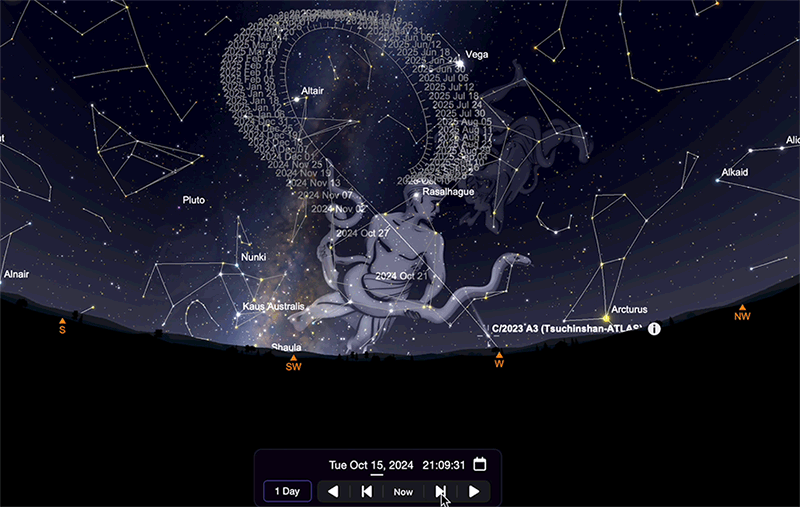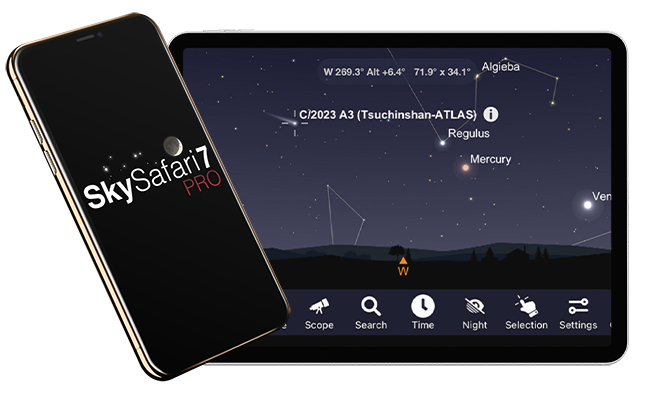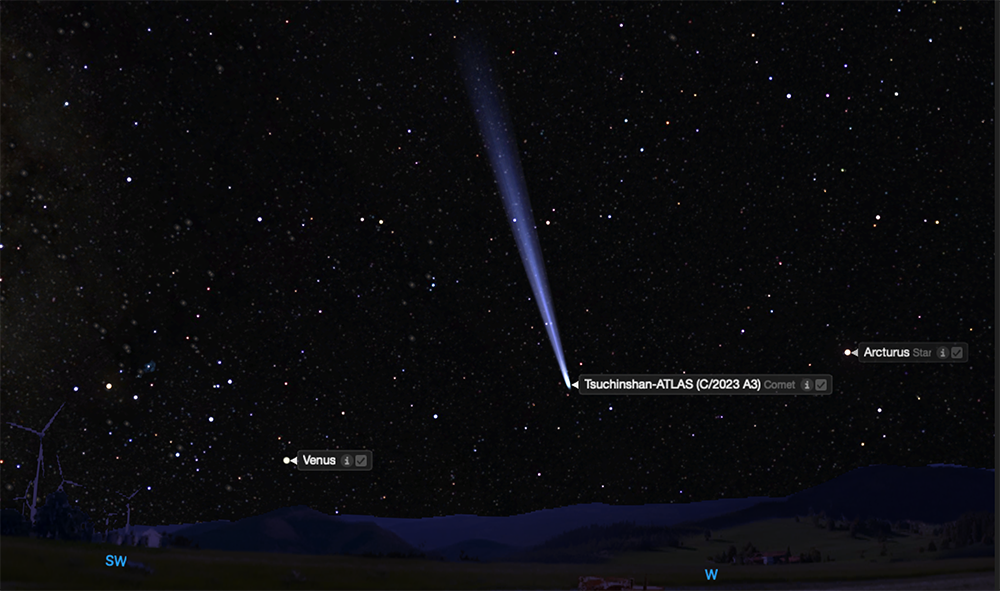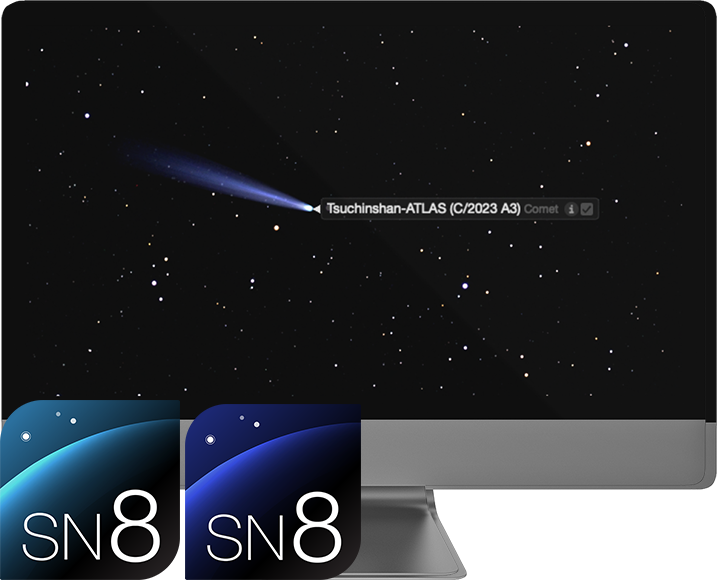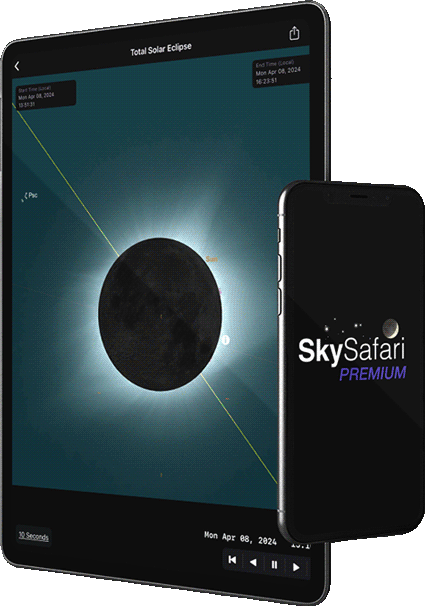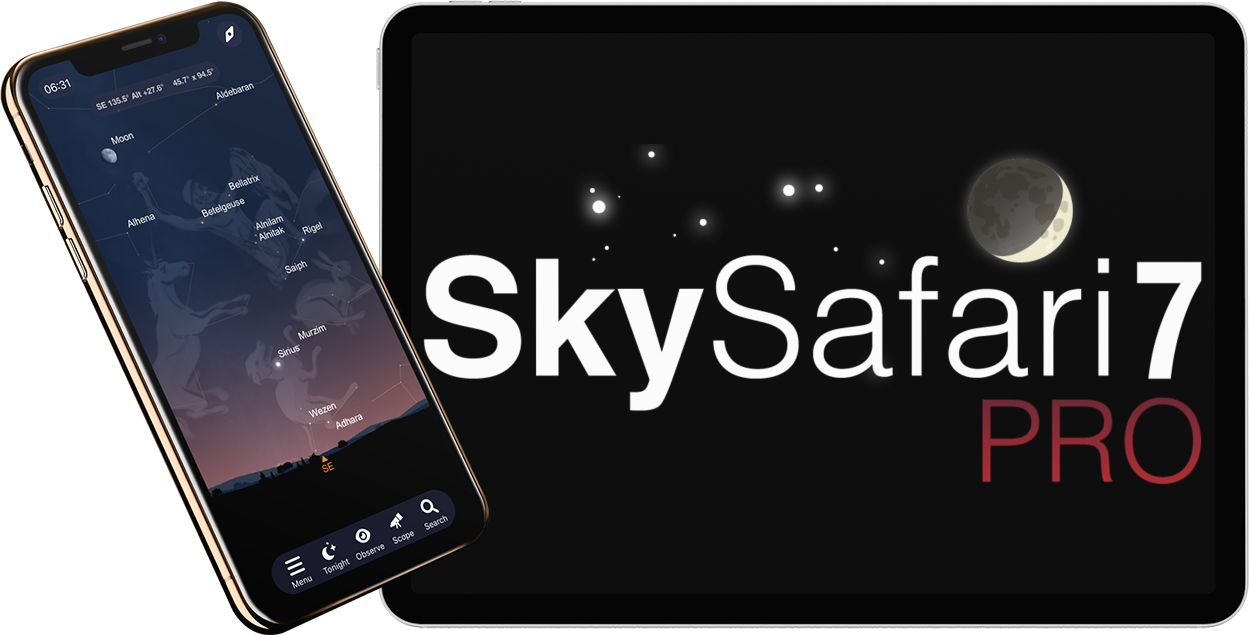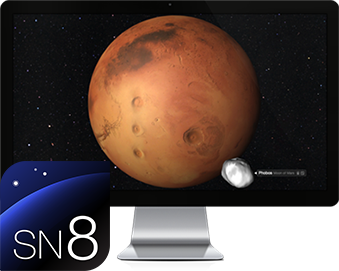Author: Joe Rao / SkySafari 7 Premium
Within the next several months, we may have a good idea as to whether we’ll have a bright naked-eye comet gracing our early autumn evening sky. The comet in question is C/2023 A3 (Tsuchinshan–ATLAS), discovered by the Asteroid Terrestrial-impact Last Alert System (ATLAS) in South Africa on February 22nd, 2023. ATLAS is a robotic early warning system developed specifically for detecting near-Earth asteroids a few weeks to just days before they might impact Earth.
Originally thought to be an asteroid, it was later determined that this same object was photographed six weeks earlier by the Purple Mountain Observatory (Tsuchinshan) in the east of Nanjing, China. It has since been determined to actually be an incoming comet.
When the comet was first sighted, it was far out beyond the orbit of Jupiter, some 680 million miles from the sun. But on September 27th of this year, Tsuchinshan–ATLAS will be making its closest approach to the sun, coming to within 36 million miles; the average distance of the planet Mercury from the sun.
And just over two weeks later, on October 12th, the comet will pass just 44 million miles from Earth.
These figures suggest that the comet might brighten to second or even first magnitude and could develop a notable tail that could make for an eye-catching sight in the western evening sky during mid-October 2024.
It could also be a dud...
Unfortunately, there is a caveat: calculations show that Tsuchinshan–ATLAS is a “first-timer,” coming directly from the Oort cloud, a spherical shell of icy space debris situated far beyond the outer limits of the solar system and thought to contain billions or even trillions of comets. Comets originating from the Oort cloud have never passed near to the sun before and their nuclei are coated with very volatile materials that vaporize far from the sun giving a short-lived surge in brightness. But as the comet gets nearer to the sun its brightening slows or even stops completely.
Most – though admittedly not all – comets originating from the Oort cloud, usually end up being duds. Typically, as these comets cross the orbit of Mars, their steady brightening trend starts to falter, signaling that they ultimately will end up underperforming.
Comet Tsuchinshan–ATLAS will not get to that point in its orbit until late July. If it then continues to steadily brighten beyond that time, then there's a good chance it will evolve into an eye-catching sight. But, more likely, if its brightening trend suddenly slows, or even comes to halt, all bets for a good show are off. Until then, all we can do is wait and watch.
Stay Updated on All Astro Events in SkySafari 7
Those in the Northern Hemisphere will not be able to check on the status of Comet Tsuchinshan–ATLAS during this summer because it will be situated much too far south to be assessable with telescopes. Those living in far-southerly locations, such as Australia, New Zealand and South America, however, will be able to track it in the morning sky before sunrise. We’ll need to rely on reports from these parts of the globe to tell us whether the comet is on track to possibly becoming a bright object.
The Best Astronomy App is SkySafari 7
Dusty reflections hold key to a good show
Another thing that could work in our favor is that the geometry of the comet relative to the sun and Earth, places it almost in-between the sun and Earth around October 8th, creating a phenomenon known as “forward scattering of sunlight.” If the comet is particularly dusty, dust particles ejected from the comet nucleus would preferentially scatter sunlight in a forward direction and could cause a dramatic upsurge in the comet’s brightness.
Some calculations suggest that Tsuchinshan–ATLAS might become as brilliant as Venus around that time – although in the sky it will also be very near to the position of the sun. In the days that follow, however, the comet should sweep rapidly northward and become well-placed for viewing in the western sky by mid-October. Although it will now be fading as it recedes from both the sun and Earth, it hopefully will be bright enough to be well-seen with the naked-eye, perhaps accompanied by a notable tail as well.
Using Starry Night Pro 8.0, I’ve provided a view of what we “might” see on October 14th. looking west about one hour after sunset. The head of the comet (known as the “coma”) is positioned roughly midway between Venus – located well to the comet’s lower left – and the bright orange star, Arcturus, situated to the comet’s upper right.
Click Below & Use Checkout Code: CometHunt60 for 60% OFF Starry Night Pro & Pro Plus 8!
No guarantees
But there are no guarantees. In the past, there have been comets that seemingly promised a great show, that failed to live up to expectations. Conversely, there have been comets that did not look like they would perform well, that ended up unexpectedly becoming celestial showpieces.
The legendary comet expert, Dr. Fred Whipple perhaps said it best when he said: “If you must bet, bet on a horse, not a comet!”
In the meantime, fingers crossed for Comet Tsuchinshan–ATLAS!
Take the best eclipse & astro experience even further with a free trial of SkySafari Premium within any V7 app. Enjoy exclusive content, interactive maps, countdown timers, audio alerts, prepared simulations & so much more. Tap "Observe" --> "Special Events" or check out featured content in the "Tonight" panel.

